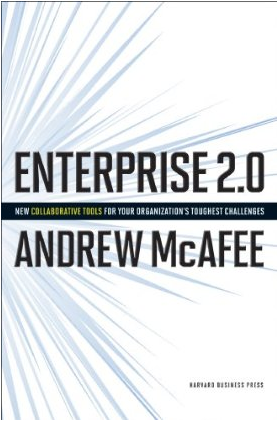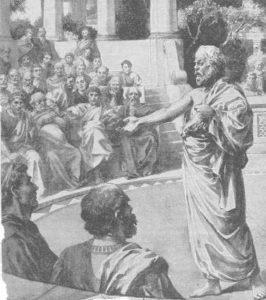 I know.
I know.
I
promised not to utilize the moniker 2.0 in 2014 but how else can I reflect back on the state of Enterprise 2.0 without actually using the term? I’ll simply lay blame to
Andrew McAfee for originally coining the term and move on.
After partaking in the June, 2011 Enterprise 2.0 conference in Boston some three years ago, I left confused if not disappointed. My sadness wasn't aimed at Andrew or the brilliance of his prescient Enterprise 2.0
observations and
subsequent book … it rested on those outside of Andrew hijacking the term Enterprise 2.0 to solely be defined as a technology change and not a behavioural change for our organizations. I mean c'mon, there once was a 2010
Enterprise 2.0 All-Star Blogger Roster put together by Mark Fidelman ... what possibly could go wrong?
One might make the argument the term Social Business is no better. (
thank you IBM)
A small part of my disdain from the 2011 conference (and the purported purpose of Enterprise 2.0 from many attendees) came through an example at the hands of a keynote delivered by
Ross Mayfield. In it he remarked:
“Discover people through content. Discover content through people,” and “Companies are not communities.”
My disappointment was easily witnessed by both my body language and
facial expressions. Is this what it had come to? I was puzzled. Wasn’t Enterprise 2.0 supposed to be the crusade against the backwards way in which enterprises actually operated? Shouldn’t Enterprise 2.0 have more to do with an organizational and leadership behavioural change than the discovery of people through content and technology? And who in their right mind would
deliver a keynote evoking such malarkey about a company not being a community, particularly if we’re using the expression Enterprise 2.0 —- which to me invoked an evolution of the enterprise from the 1.0 version of hierarchy, command and control, fiefdoms, and so on to a more collaborative 2.0 iteration.
 I then got mad.
I then got mad.
It was — and still is — my belief that people connect to people, not to technology or content. Who creates the technology or the content in the first place?
What we have wrestled with for decades, however, is the notion that
managers control employees. That is not the connection of people to people, it’s the ownership and manipulation of assets to ensure some form of action will complete. It is the parent-child syndrome cemented by a
Frederick Taylor stopwatch. It’s as though
John Cage was laughing at us. He once said,
“I can't understand why people are frightened by new ideas. I’m frightened of old ones,”
with the ‘old idea’ I’m referring to being the use of technology to define the next stage of the enterprise. New technology has always been of tremendous value to the organization, be it the printing press, the assembly line, the fax machine, the water cooler, the mobile phone … even the light bulb. But if we were to talk about the next generation of the enterprise — Enterprise 2.0 — how could we not discuss behaviour, culture, learning or leadership in concert with the premise of collaborative-based technologies?

It was a moment I will never forget. Perhaps due to the fact I was on a mission at
TELUS — where I was plying my trade at the time — to help our organization redefine and refine its culture, its leadership and its learning models … aided and abetted by technology, but not defined by it. By the Fall of 2011 I felt somewhat vindicated as employee engagement rose from 57% to 70%, with further increases occurring in 2012 (80%) and 2013 (83%). Those increases (and subsequent
business benefits) came not as a result of an Enterprise 2.0 technology strategy, rather as an overarching refinement of core
leadership, learning
and collaboration practices. Alongside other factors at TELUS such as our
community investment and
recognition programs, the organization demonstrated that
culture was in fact a competitive advantage.
Since the inception of the term Enterprise 2.0 — unfortunately for Andrew, I imagine — technology vendors have sabotaged its intent. Wiki’s, blogs, micro-blogging, video sharing, and the like won’t improve your culture absolutely or in isolation nor will it drive a better state of employee engagement if that is the only strategy applied. It can certainly assist, but it alone will not become the saviour. That’s when the
‘lipstick on a pig’ analogy comes out in droves.
Which is why I’m proud to write today that I’m getting somewhat happier.
I’m not as mad anymore. (well, I still loathe many of the technology vendors out there as they continue to sell function over form, and tools over behaviour, but hope is on the horizon as it relates to those that are taking the torch forward for true organizational culture change)

Fresh off a keynote at the 2014 Enterprise 2.0 Summit in Paris, (
watch the video) I’m delighted to let you know that Enterprise 2.0 is growing up.
Imagine a conference sponsored primarily by technology vendors only to see a large percentage of the presentations focusing on … wait for it … organizational culture, leadership and behaviour.
It was amazing.
And there wasn’t a single technology demo showcased on the main stage, at least to my knowledge.
How refreshing.
It didn’t matter what session you sat in on, the thread was similar and centred on the changes that are needed to make the organization more fluid, dynamic, collaborative and arguably more human as we shift into the second gear of the 21st century. Charles Handy and Peter Drucker would be proud.
And something else was prevalent throughout the two days.

Whether on the coffee breaks or in the hallways in addition to the Twitter back-channel, the primary theme being chatted about was culture.
Culture.
Imagine that.
It was as though everyone had read
Flat Army.
If I could, I’d like to travel back in time, specifically to the era of the Greek philosophers like Socrates, Aristotle, Plato and even Epicurus. They walked around speaking, writing and philosophizing about concepts such as happiness, wellness, meaning, courage, virtue, honour amongst countless other topics.
I’d like to travel back in time because I want to know what it felt like to discuss change, life and the pursuit (or at least definition) of eudaimonia -
a contented state of being happy and healthy and prosperous. I want to know because I like to think the discussions that were happening over those two days in Paris — coupled by an eerily similar time at the
Drucker Forum in Vienna in 2013 — were an evolution of sorts to Enterprise 2.0.

I’m paying homage to the Greeks and how they thought out loud about society, ultimately helping others through their thinking and teaching that there was (or is) a better way of living. The Greeks were teachers. They were open and thought passionately about people. They disagreed out loud with one another — and in the case of Socrates, were given the
death penalty of hemlock poison (or
suicide, depends who you believe) by the government of the day — but they all urged others to see life in a different light.
Many of us have been on this walk and journey for years now. Current day renaissance philosophers such as Jon Husband, Harold Jarche, Luis Suarez, Kenneth Mikkelsen, Richard Martin, David Terrar, Thierry de Baillon, Celine Schillinger, Sara Roberts, Rachel Happe, Marcia Conner, Gautam Ghosh, Fredrik Matheson, Rawn Shah, Steve Denning, Richard Straub, Tim McDonald, John Hagel, Lee Bryant, Anne Marie McEwan, Jon Ingham amongst many others have been selflessly beating the drum of organizational culture change - yearning for it to evolve and to take shape.
Our
‘out loud’ discussions focus on new (and open) leadership practices, aided and abetted by technologies. (not implementing technology as the antidote for culture change)
I'd include Chris Heuer in the list above and who rather brilliantly
asked us in late 2013 to:
"connect with each other and figure out how to re-imagine our broken corporations and set about trying to fix them."
These are the
new Greeks ... openly discussing tomorrow’s organizational constructs and cultural requirements. You can be one too.
In conclusion, something happened in Paris. Perhaps the dots simply connected for me, personally.
Perhaps Enterprise 2.0 is finally moving from potential energy to kinetic energy. Of course I’ve always been aligned with Tolstoy in my life:
“The two most powerful warriors are patience and time.”
Enterprise 2.0 seems to have stopped being a technology and it has become a quest for true culture change and reinvention of the organization. The conversations proved it. The
new Greeks are a force to be reckoned with now. The talk, however, must now turn into actions of change for the multitude of organizations in cultural dire straits. No more diagrams. Time is ticking away.
If you are, however, an Enterprise 2.0 technology vendor reading this … it’s time to start thinking similarly if you haven’t done so already.
Time is not on your side either.
PS. Wilke Riesenbeck did a great job
recapping the E2.0 Summit as did
Richard Martin.
 I know.
I promised not to utilize the moniker 2.0 in 2014 but how else can I reflect back on the state of Enterprise 2.0 without actually using the term? I’ll simply lay blame to Andrew McAfee for originally coining the term and move on.
After partaking in the June, 2011 Enterprise 2.0 conference in Boston some three years ago, I left confused if not disappointed. My sadness wasn't aimed at Andrew or the brilliance of his prescient Enterprise 2.0 observations and subsequent book … it rested on those outside of Andrew hijacking the term Enterprise 2.0 to solely be defined as a technology change and not a behavioural change for our organizations. I mean c'mon, there once was a 2010 Enterprise 2.0 All-Star Blogger Roster put together by Mark Fidelman ... what possibly could go wrong?
One might make the argument the term Social Business is no better. (thank you IBM)
A small part of my disdain from the 2011 conference (and the purported purpose of Enterprise 2.0 from many attendees) came through an example at the hands of a keynote delivered by Ross Mayfield. In it he remarked:
I know.
I promised not to utilize the moniker 2.0 in 2014 but how else can I reflect back on the state of Enterprise 2.0 without actually using the term? I’ll simply lay blame to Andrew McAfee for originally coining the term and move on.
After partaking in the June, 2011 Enterprise 2.0 conference in Boston some three years ago, I left confused if not disappointed. My sadness wasn't aimed at Andrew or the brilliance of his prescient Enterprise 2.0 observations and subsequent book … it rested on those outside of Andrew hijacking the term Enterprise 2.0 to solely be defined as a technology change and not a behavioural change for our organizations. I mean c'mon, there once was a 2010 Enterprise 2.0 All-Star Blogger Roster put together by Mark Fidelman ... what possibly could go wrong?
One might make the argument the term Social Business is no better. (thank you IBM)
A small part of my disdain from the 2011 conference (and the purported purpose of Enterprise 2.0 from many attendees) came through an example at the hands of a keynote delivered by Ross Mayfield. In it he remarked:
 I then got mad.
It was — and still is — my belief that people connect to people, not to technology or content. Who creates the technology or the content in the first place?
What we have wrestled with for decades, however, is the notion that managers control employees. That is not the connection of people to people, it’s the ownership and manipulation of assets to ensure some form of action will complete. It is the parent-child syndrome cemented by a Frederick Taylor stopwatch. It’s as though John Cage was laughing at us. He once said,
I then got mad.
It was — and still is — my belief that people connect to people, not to technology or content. Who creates the technology or the content in the first place?
What we have wrestled with for decades, however, is the notion that managers control employees. That is not the connection of people to people, it’s the ownership and manipulation of assets to ensure some form of action will complete. It is the parent-child syndrome cemented by a Frederick Taylor stopwatch. It’s as though John Cage was laughing at us. He once said,
 It was a moment I will never forget. Perhaps due to the fact I was on a mission at TELUS — where I was plying my trade at the time — to help our organization redefine and refine its culture, its leadership and its learning models … aided and abetted by technology, but not defined by it. By the Fall of 2011 I felt somewhat vindicated as employee engagement rose from 57% to 70%, with further increases occurring in 2012 (80%) and 2013 (83%). Those increases (and subsequent business benefits) came not as a result of an Enterprise 2.0 technology strategy, rather as an overarching refinement of core leadership, learning and collaboration practices. Alongside other factors at TELUS such as our community investment and recognition programs, the organization demonstrated that culture was in fact a competitive advantage.
Since the inception of the term Enterprise 2.0 — unfortunately for Andrew, I imagine — technology vendors have sabotaged its intent. Wiki’s, blogs, micro-blogging, video sharing, and the like won’t improve your culture absolutely or in isolation nor will it drive a better state of employee engagement if that is the only strategy applied. It can certainly assist, but it alone will not become the saviour. That’s when the ‘lipstick on a pig’ analogy comes out in droves.
Which is why I’m proud to write today that I’m getting somewhat happier.
I’m not as mad anymore. (well, I still loathe many of the technology vendors out there as they continue to sell function over form, and tools over behaviour, but hope is on the horizon as it relates to those that are taking the torch forward for true organizational culture change)
It was a moment I will never forget. Perhaps due to the fact I was on a mission at TELUS — where I was plying my trade at the time — to help our organization redefine and refine its culture, its leadership and its learning models … aided and abetted by technology, but not defined by it. By the Fall of 2011 I felt somewhat vindicated as employee engagement rose from 57% to 70%, with further increases occurring in 2012 (80%) and 2013 (83%). Those increases (and subsequent business benefits) came not as a result of an Enterprise 2.0 technology strategy, rather as an overarching refinement of core leadership, learning and collaboration practices. Alongside other factors at TELUS such as our community investment and recognition programs, the organization demonstrated that culture was in fact a competitive advantage.
Since the inception of the term Enterprise 2.0 — unfortunately for Andrew, I imagine — technology vendors have sabotaged its intent. Wiki’s, blogs, micro-blogging, video sharing, and the like won’t improve your culture absolutely or in isolation nor will it drive a better state of employee engagement if that is the only strategy applied. It can certainly assist, but it alone will not become the saviour. That’s when the ‘lipstick on a pig’ analogy comes out in droves.
Which is why I’m proud to write today that I’m getting somewhat happier.
I’m not as mad anymore. (well, I still loathe many of the technology vendors out there as they continue to sell function over form, and tools over behaviour, but hope is on the horizon as it relates to those that are taking the torch forward for true organizational culture change)
 Fresh off a keynote at the 2014 Enterprise 2.0 Summit in Paris, (watch the video) I’m delighted to let you know that Enterprise 2.0 is growing up.
Imagine a conference sponsored primarily by technology vendors only to see a large percentage of the presentations focusing on … wait for it … organizational culture, leadership and behaviour.
It was amazing.
And there wasn’t a single technology demo showcased on the main stage, at least to my knowledge. How refreshing.
It didn’t matter what session you sat in on, the thread was similar and centred on the changes that are needed to make the organization more fluid, dynamic, collaborative and arguably more human as we shift into the second gear of the 21st century. Charles Handy and Peter Drucker would be proud.
And something else was prevalent throughout the two days.
Fresh off a keynote at the 2014 Enterprise 2.0 Summit in Paris, (watch the video) I’m delighted to let you know that Enterprise 2.0 is growing up.
Imagine a conference sponsored primarily by technology vendors only to see a large percentage of the presentations focusing on … wait for it … organizational culture, leadership and behaviour.
It was amazing.
And there wasn’t a single technology demo showcased on the main stage, at least to my knowledge. How refreshing.
It didn’t matter what session you sat in on, the thread was similar and centred on the changes that are needed to make the organization more fluid, dynamic, collaborative and arguably more human as we shift into the second gear of the 21st century. Charles Handy and Peter Drucker would be proud.
And something else was prevalent throughout the two days.
 Whether on the coffee breaks or in the hallways in addition to the Twitter back-channel, the primary theme being chatted about was culture.
Whether on the coffee breaks or in the hallways in addition to the Twitter back-channel, the primary theme being chatted about was culture.
 I’m paying homage to the Greeks and how they thought out loud about society, ultimately helping others through their thinking and teaching that there was (or is) a better way of living. The Greeks were teachers. They were open and thought passionately about people. They disagreed out loud with one another — and in the case of Socrates, were given the death penalty of hemlock poison (or suicide, depends who you believe) by the government of the day — but they all urged others to see life in a different light.
Many of us have been on this walk and journey for years now. Current day renaissance philosophers such as Jon Husband, Harold Jarche, Luis Suarez, Kenneth Mikkelsen, Richard Martin, David Terrar, Thierry de Baillon, Celine Schillinger, Sara Roberts, Rachel Happe, Marcia Conner, Gautam Ghosh, Fredrik Matheson, Rawn Shah, Steve Denning, Richard Straub, Tim McDonald, John Hagel, Lee Bryant, Anne Marie McEwan, Jon Ingham amongst many others have been selflessly beating the drum of organizational culture change - yearning for it to evolve and to take shape.
Our ‘out loud’ discussions focus on new (and open) leadership practices, aided and abetted by technologies. (not implementing technology as the antidote for culture change)
I'd include Chris Heuer in the list above and who rather brilliantly asked us in late 2013 to:
I’m paying homage to the Greeks and how they thought out loud about society, ultimately helping others through their thinking and teaching that there was (or is) a better way of living. The Greeks were teachers. They were open and thought passionately about people. They disagreed out loud with one another — and in the case of Socrates, were given the death penalty of hemlock poison (or suicide, depends who you believe) by the government of the day — but they all urged others to see life in a different light.
Many of us have been on this walk and journey for years now. Current day renaissance philosophers such as Jon Husband, Harold Jarche, Luis Suarez, Kenneth Mikkelsen, Richard Martin, David Terrar, Thierry de Baillon, Celine Schillinger, Sara Roberts, Rachel Happe, Marcia Conner, Gautam Ghosh, Fredrik Matheson, Rawn Shah, Steve Denning, Richard Straub, Tim McDonald, John Hagel, Lee Bryant, Anne Marie McEwan, Jon Ingham amongst many others have been selflessly beating the drum of organizational culture change - yearning for it to evolve and to take shape.
Our ‘out loud’ discussions focus on new (and open) leadership practices, aided and abetted by technologies. (not implementing technology as the antidote for culture change)
I'd include Chris Heuer in the list above and who rather brilliantly asked us in late 2013 to:






